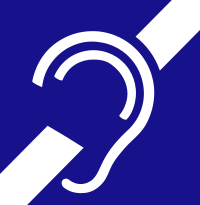
Photo from wikipedia
Single-sided deafness (SSD) is a condition where an individual has non-functional hearing in one ear and receives no clinical benefit from amplification in that ear, with the contralateral ear possessing… Click to show full abstract
Single-sided deafness (SSD) is a condition where an individual has non-functional hearing in one ear and receives no clinical benefit from amplification in that ear, with the contralateral ear possessing normal audiometric function. Cochlear implant presents a good choice in rehabilitation of SSD. The presence of a deficient cochlear nerve (CN) has been linked to poor performance with cochlear implants. CN can be measured by imaging techniques. The objective of this study was to compare CN diameter in patients who had a history of single-sided deafness because of sudden hearing loss. Retrospective study where radiologist was blind designed. 53 SSD patients who had a history of sudden hearing loss and MRI at least 5 years after the sudden hearing loss were included in this retrospective study. High-resolution 3-D constructive interference in steady state (CISS)-sequence magnetic resonance (MRI) images was review by the neurotology-experienced blind radiologist. Vertical, horizontal and area measurements of cochlear nerve between the deaf and the normal ear were made. There was no statistically significant difference between the normal ear and deaf ear of the subjects in terms of cochlear nerve vertical diameter, horizontal diameter and area. (respectively, p = 0.250; p = 0.183; p = 0.874) The numbers of remaining cochlear neurons and spiral ganglion cells in the implanted deaf ears are critical and evidence was not found for spiral ganglion cell loss in the sudden hearing loss deaf ear with SSD in MRI. In the light of all these findings, implantation would be a good choice for rehabilitation in postlingual SSD regardless of auditory deprivation duration.
Journal Title: European Archives of Oto-Rhino-Laryngology
Year Published: 2020
Link to full text (if available)
Share on Social Media: Sign Up to like & get
recommendations!